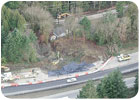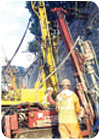
In the past, compressed air and various drilling fluids have been used as circulating media while drilling through earth embankments and their foundations. Although these methods have been used successfully in accomplishing the intended purposes, there have been many incidents of damage to embankments and foundations. While using air (including air with foam), there have been reports of loss of circulation with pneumatic fracturing of the embankment as evidenced by connections to other borings and blowouts on embankment slopes. While using water as the circulating medium, there have been similar reports of erosion and/or hydraulic fracturing of the embankment or foundation materials.
Drilling Procedures
Holes into or through an embankment should be drilled with a non-coring type roller (preferred), fishtail or other suitable bit as necessary to drill a minimum 5 1⁄2-inch diameter hole in the embankment and overburden. Where practicable, openings or nozzles directing flow of the circulation fluid should be upward or side discharge. A commercial drilling mud shall be used as the drilling fluid. The mud should have sufficient consistency and weight to prevent caving and minimize intrusion of the drilling mud into the embankment and overburden. Thorough washing out and removal of all cuttings during drilling is essential.Upon reaching foundation rock, a 3-inch O.D. (3-in. I.D.) flush-joint casing is inserted in the hole and firmly seated in rock. After seating the casing, drilling mud should be flushed from inside the casing. However, mud must be maintained outside the casing until it is removed from the hole after backfilling. Every effort should be made to avoid loss of circulation and embankment damage.
Excess drill penetration rate or down pressure may cause embankment damage. What constitutes “normal” and “excessive” drilling parameters can be expected to vary considerably from embankment to embankment, and from hole to hole. Normal drilling parameters should be established during initial drilling of an embankment in a relatively clean hole.
A drilling rate of not more than 5 feet penetration in five minutes should be maintained when drilling in clay. To prevent damage from clay buildup on the drill rods or balling of the bit and overloading (clogging) the annulus of the hole, the drill stem should be slowly raised and cleaned if clay buildup occurs.
Surges in pumping rate or pressure need to be avoided. Pump pressure and drill down-pressure readings must be monitored continually. If the pump pressure increases by 50 percent during the drilling of any 5-foot increment, the bit should be picked up slowly and the hole allowed to clean.
Attempt to drill through any tight sections. Do not advance the hole by rapid raising and lowering of the drill tools. Raise or lower drill tools slowly to prevent pressure changes that cause caving.
Run the pump for 15 seconds with the bit on the bottom of the hole before adding a joint of drill rod.
Operate the pump at the lowest rate that will assure adequate cooling and cleaning of the bit and removal of cuttings.

Drilling Fluid Matters
A mixing tub or holding tank large enough to hold an adequate quantity (at least 1.5 times the hole volume) of drilling fluid mix should be maintained on site. This will ensure that the hole is filled with drilling fluid and kept open at all times.The maximum allowable mud weight is 72 pounds per square foot. Drilling mud viscosity also should be monitored continually using a Marsh funnel, and should be maintained within 60 seconds to 70 seconds. Drilling mud should be weighed every 15 minutes, adding water or new mix while drilling to maintain minimum weight (hydrostatic head and solids content), viscosity (pressure in the annulus while circulating) and filtration (filter cake restriction of the annulus). Adjustments should be made to the drilling mud during the drilling operation if problems or unfavorable results occur, such as clay buildup.
Backfilling Holes
After the rock section of the hole has been grouted to refusal, the casing should be pulled to approximately 3 feet above top of rock. The grout injection pipe then should be pulled to near top of rock. Backfilling of holes in overburden and/or an earthen embankment is accomplished by injection of grout through a tremie pipe or hose inserted to a depth below top of rock. The backfill or grout mix should be changed to an appropriate mix that approximates the properties of the undisturbed embankment. The hole should then be backfilled (grouted) to a level not to exceed approximately 50 feet above the casing bottom. The estimated quantity for backfill grout always should be calculated before starting backfilling operations, and injection quantities must be monitored continuously. If the estimated quantity per linear foot of hole is exceeded by a meaningful amount at any time, operations should be halted, and the casing pulled to the top of the grout, and the backfill allowed to set. Prescribed backfilling operations then can resume. The casing should then be slowly pulled a maximum of 15 feet above top of rock, the injection pipe pulled approximately 5 feet above top of rock, and the hole again grouted to a level not to exceed 50 feet above casing bottom.The injection pipe and casing the should be withdrawn in increments not to exceed approximately 50 feet, keeping the hole filled with the backfill mix to a level not to exceed approximately 50 feet above casing bottom at all times. After the casing has been removed, the hole should be periodically checked for a period of 24 hours, and kept full of backfill mix until the material has set.
Backfilling of holes in an embankment in which an instrument has been installed will be in accordance with prescribed procedures for that instrument.
ND
This article is provided through the courtesy of the U.S. Army Corps of Engineers.
Report Abusive Comment